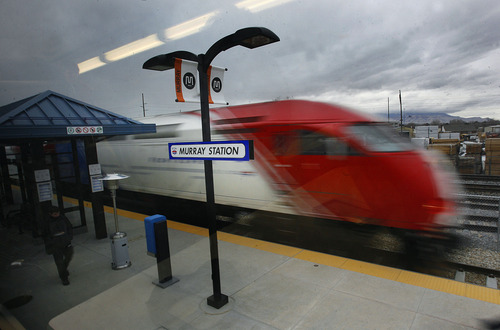This is an archived article that was published on sltrib.com in 2013, and information in the article may be outdated. It is provided only for personal research purposes and may not be reprinted.
With the incentive of a 20 percent discount on train and bus fares until mid-March, the Utah Transit Authority has managed to sell 2,172 of its new prepaid, reloadable electronic FAREPAY cards in the first month they have been available.
"This is especially encouraging since our bigger retail partners are still just beginning to offer the cards in their stores," said UTA spokesman Remi Barron.
He said 77 merchant locations are now offering the cards, and another 35 are nearly ready to do so. UTA hopes to have hundreds of retail locations offering the card by later this year. Retailers who have agreed to participate include Walgreens, Wal-Mart, 7-Eleven and Associated Food stores.
With the limited retail locations available so far, UTA said 36 percent of the cards sold were at its customer service centers. Another 36 percent were sold online at rideuta.com, where a list of retailers is also available.
To encourage use of the cards, UTA is offering discounts of up to 20 percent off regular cash fares through March 14. So card users are charged only $2 for a one-way bus or TRAX trip that normally costs $2.50. Also, those who use electronic media to pay fares on the new Sugar House Streetcar line that opens Dec. 8 will be charged only $1, instead of the normal $2.50, as part of a limited-time promotional offer.
FAREPAY cards have a one-time $3 activation fee, and riders can load and reload any amount from $5 to $500 in stores or online.
UTA says the cards allow riders not to worry about finding correct change when riding buses or standing in line at ticket machines for trains. FAREPAY also allows UTA to gather better data about where and when riders travel, and adjust service accordingly.
When riding a bus or FrontRunner train, those using FAREPAY cards must tap on electronic readers before boarding and tap off when transferring or exiting the system. When riding TRAX, riders only need to tap between the first and last stations, and do not need to tap when transferring between TRAX lines.
If riders forget to tap off after any service, they will not receive a transfer credit — and also will be charged for full-length-of-line trips on FrontRunner.
"Overall, the system is working well with very few glitches," Barron said.
Use of the new cards is also seen as a needed step for UTA to switch eventually to a distance-based fare system that would charge fares based on length of trips instead of the current flat rate for trips of any length.



